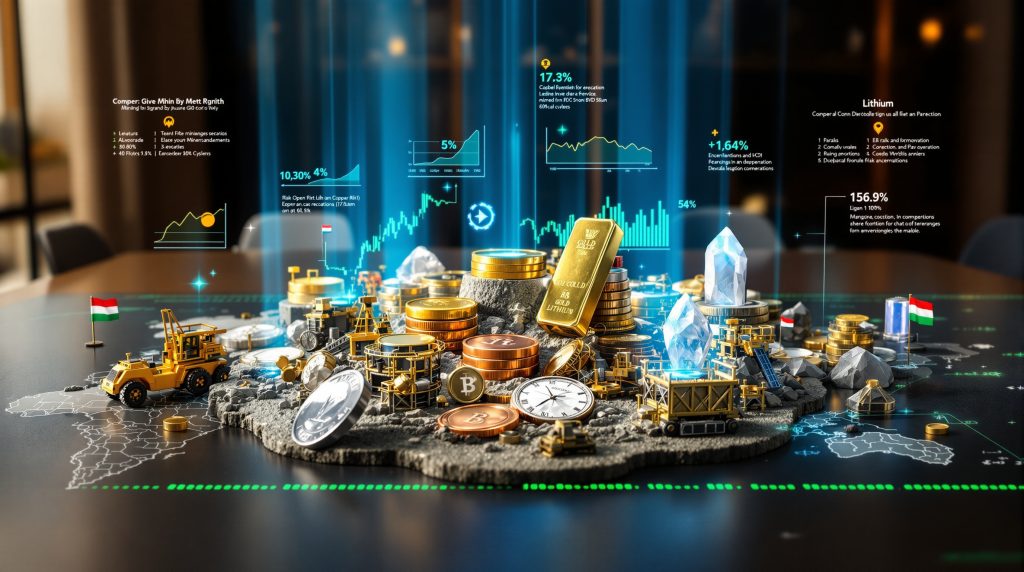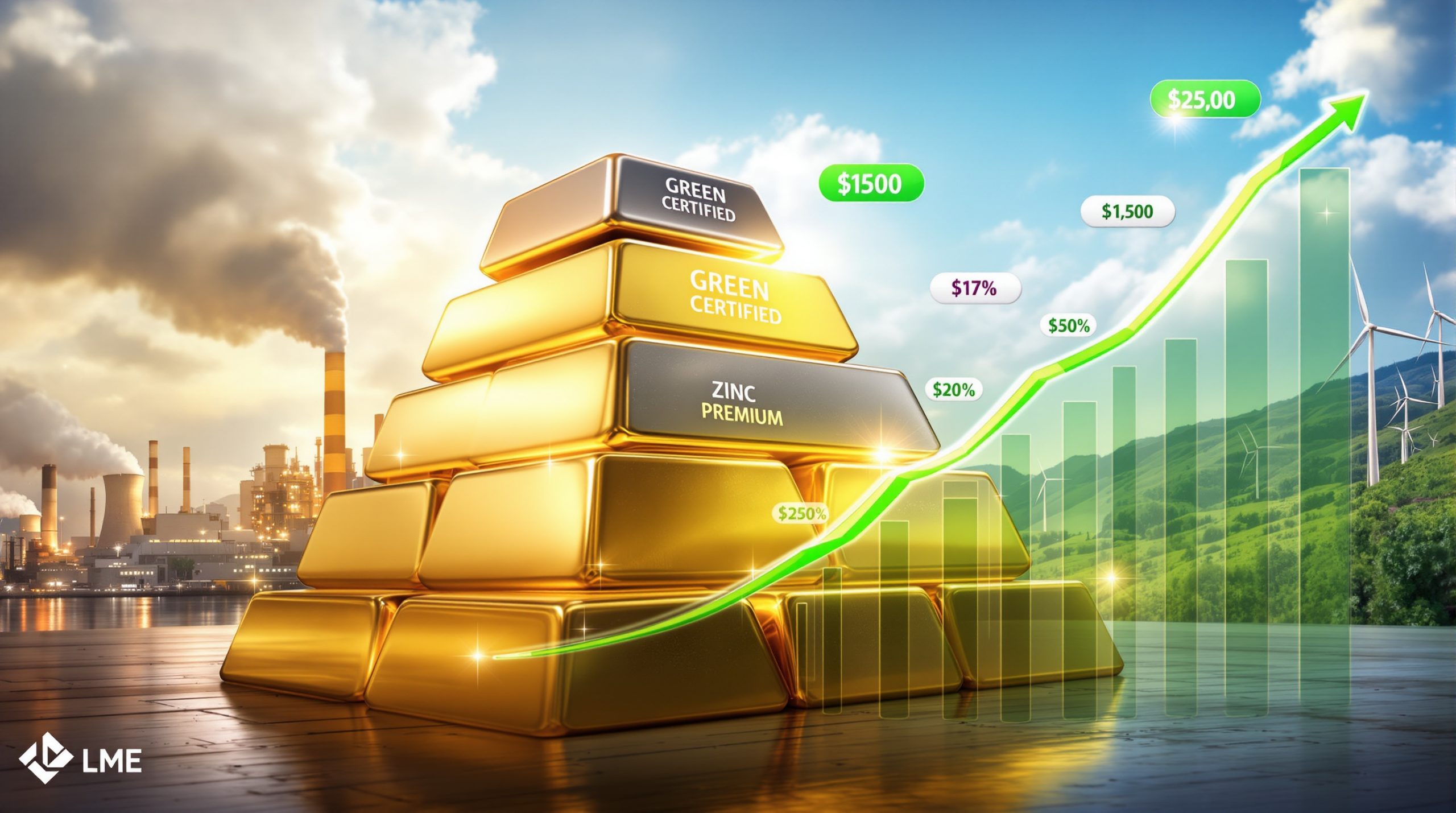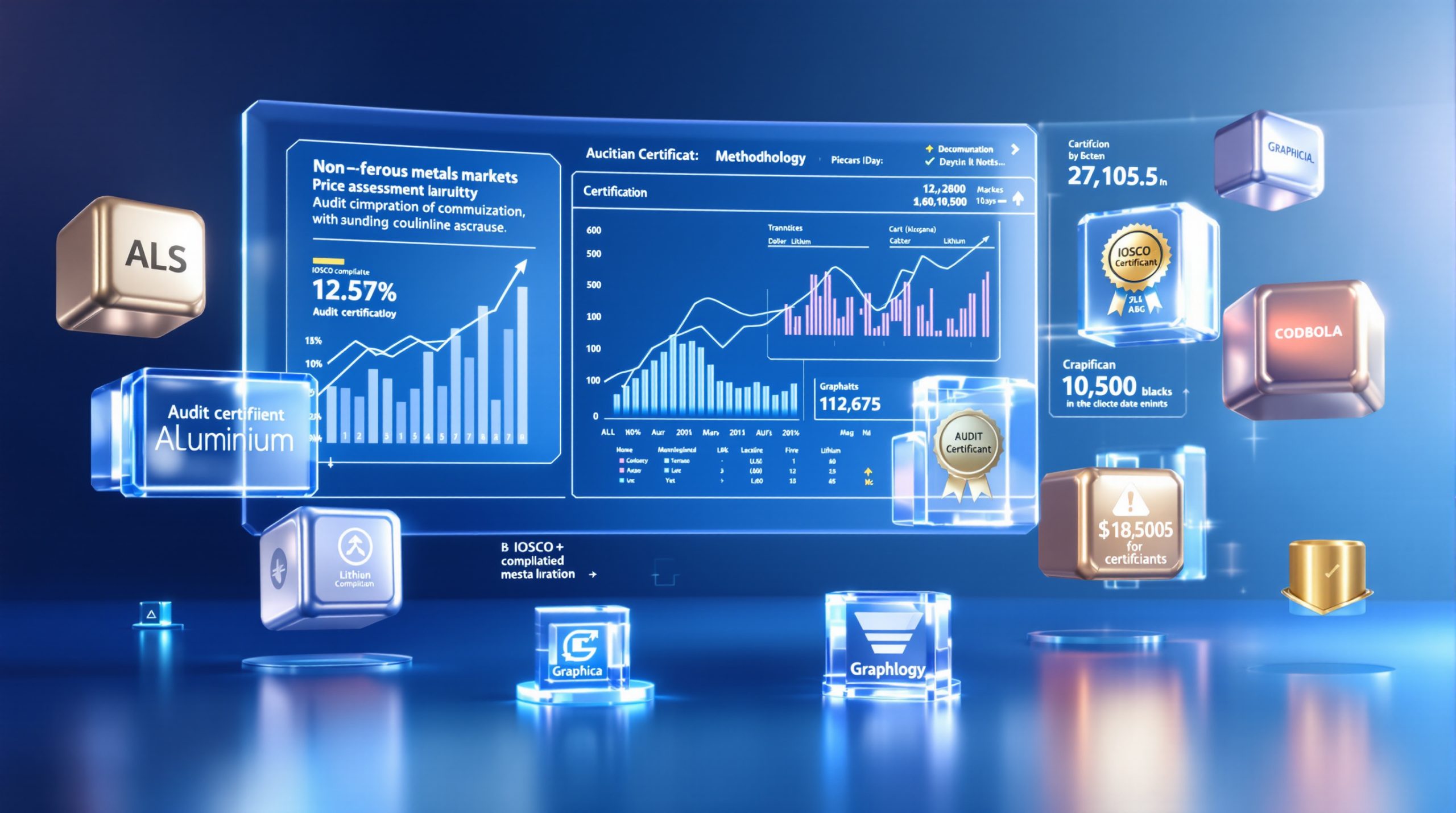Why Diversification Matters in the Metals and Mining Sector
The metals and mining sector offers unique diversification opportunities for investors seeking to balance risk and reward in their portfolios. Unlike more homogeneous industries, this sector encompasses a vast spectrum of commodities, company types, and geographic exposures that respond differently to economic cycles, geopolitical events, and technological shifts.
Effective diversification requires understanding not just the commodities themselves, but also the complex interplay between global macro trends, company-specific factors, and regional dynamics. This approach becomes particularly valuable during periods of market volatility or economic uncertainty.
According to the World Gold Council, gold typically shows negative correlation with equities during market stress periods, while industrial metals like copper demonstrate positive correlation during growth phases. This contrast creates natural portfolio protection mechanisms when these assets are combined strategically.
Position sizing emerges as a critical factor in metals investing. Industry professionals emphasize that allocating appropriate percentages to different metal categories based on their volatility profiles often proves more important than asset selection itself. This discipline allows investors to maintain conviction through inevitable market fluctuations.
How Do Commodity Cycles Impact Investment Strategies?
Understanding the Unique Nature of Metal Cycles
Metal price cycles typically follow patterns that differ significantly from broader market cycles. Gold, for instance, often performs strongly during periods of economic uncertainty, while industrial metals like copper tend to thrive during economic expansion phases. This counter-cyclical relationship creates natural diversification benefits when these assets are combined strategically.
These cycles are influenced by:
- Supply constraints (mine development timelines of 5-10 years)
- Demand fluctuations (technological adoption, infrastructure spending)
- Inventory levels across the supply chain
- Currency movements, particularly the US dollar
According to S&P Global Market Intelligence, the average time from discovery to production for major mining projects ranges from 10-20 years, with copper projects averaging 16 years. This extended timeline creates natural supply constraints that can drive price appreciation when demand accelerates.
Recognizing Where We Stand in Current Cycles
The current commodity cycle presents a unique set of circumstances. Many metals are experiencing significant supply constraints after years of underinvestment, while demand projections remain robust due to energy transition requirements and infrastructure development.
The International Energy Agency reports that announced mining projects for critical minerals fall short of projected demand scenarios, with copper price insights potentially facing supply deficits by 2030 under clean energy transition scenarios. This supply-demand imbalance creates potential investment opportunities for forward-thinking investors.
For investors, identifying where different metals stand in their respective cycles helps determine optimal allocation timing and weighting. This cycle-aware approach allows for strategic positioning ahead of potential price movements rather than chasing performance after significant moves have already occurred.
What Are the Key Categories for Metals and Mining Diversification?
Precious Metals: Beyond Simple Safe-Haven Status
Precious metals serve as both monetary assets and industrial inputs, creating a dual-demand profile that can be advantageous in a diversified portfolio:
-
Gold: Traditionally viewed as a monetary metal and inflation hedge, gold has maintained its purchasing power over centuries. According to historical analysis from the World Gold Council, an ounce of gold could buy approximately 350 loaves of bread in ancient Rome and can purchase roughly the same amount today.
-
Silver: With its dual role as both an industrial metal (solar panels, electronics) and monetary asset, silver often experiences higher volatility than gold but can outperform during periods of industrial growth.
-
Platinum and Palladium: These metals, critical for automotive catalytic converters and other industrial applications, respond more directly to industrial demand cycles while still maintaining precious metal characteristics.
Central bank gold purchases reached 1,037 tonnes in 2023, the second-highest year on record according to the World Gold Council, demonstrating significant institutional demand for the metal as a reserve asset. Furthermore, gold safe‑haven insights continue to support its role in portfolio diversification in metals and mining.
Base Metals: The Foundation of Industrial Growth
Base metals form the backbone of industrial development and are particularly sensitive to economic growth trends:
-
Copper: Often called "Dr. Copper" for its ability to predict economic trends, this metal is essential for electrical applications and renewable energy infrastructure.
-
Nickel: Critical for stainless steel production and increasingly important for electric vehicle batteries, nickel demand is projected to grow significantly.
-
Zinc and Lead: These metals play crucial roles in galvanizing, battery production, and various industrial applications.
Battery Metals: Powering the Energy Transition
The growing demand for energy storage solutions has created a distinct category of metals with their own supply-demand dynamics:
-
Lithium: Essential for lithium-ion batteries, this metal faces potential supply constraints despite rapid demand growth from electric vehicles and grid storage. The International Energy Agency projects global lithium demand to increase over 40-fold by 2040 under stated policy scenarios.
-
Cobalt: Used to enhance battery stability and performance, cobalt supply is concentrated in politically complex regions, creating unique risk factors.
-
Rare Earth Elements: Critical for permanent magnets in electric motors and various high-tech applications, these elements face geopolitical supply risks due to processing concentration. The U.S. Geological Survey reports that China controls approximately 60% of global rare earth mining and 85-90% of rare earth processing capacity.
Recent lithium industry innovations are reshaping this segment of the market, providing new opportunities for portfolio diversification.
What Investment Vehicles Provide Optimal Exposure?
Physical Metal Holdings vs. Paper Assets
Investors can gain exposure through various vehicles, each with distinct risk-reward characteristics:
| Investment Vehicle | Advantages | Considerations |
|---|---|---|
| Physical Metals | Direct ownership, no counterparty risk | Storage costs, insurance, liquidity challenges |
| ETFs & ETNs | Liquidity, ease of trading, low minimum investment | Management fees, potential tracking error |
| Mining Equities | Operational leverage to metal prices, dividend potential | Company-specific risks, operational challenges |
| Futures & Options | Leverage, hedging capabilities | Complexity, roll costs, time decay (options) |
| Royalty & Streaming Companies | Reduced operational risk, exposure to multiple projects | Premium valuations, limited universe of companies |
As of 2024, gold-backed ETFs held approximately 3,200 tonnes of gold, representing roughly $200 billion in assets under management according to World Gold Council data.
Mining Equities: Balancing Company Size and Focus
Mining companies offer varying risk-reward profiles based on their size, focus, and business model:
-
Major Diversified Miners: Companies like BHP, Rio Tinto, and Vale provide exposure across multiple commodities, reducing single-metal risk while offering dividend income potential.
-
Mid-Tier Producers: These companies typically focus on one or two primary metals but have established production and cash flow, balancing growth potential with operational stability.
-
Junior Explorers and Developers: Offering the highest potential returns but with corresponding risk, these companies focus on discovering and developing new resources before production begins.
Mining equities typically provide 2-3x leverage to underlying metal price movements during bull markets due to their fixed cost structures, where price increases flow directly to margins and cash flows.
Royalty and Streaming Companies: A Hybrid Approach
Royalty and streaming companies provide financing to miners in exchange for a percentage of future production or revenue, offering:
- Exposure to metal price upside without direct operational risks
- Portfolio diversification across multiple projects and jurisdictions
- Often higher margins and stronger balance sheets than traditional miners
- Potential for dividend growth as projects mature
This business model offers metal price exposure while avoiding direct operational risks, often resulting in higher margins and stronger balance sheets compared to traditional mining operations.
How Should Geographic Exposure Be Balanced?
Evaluating Jurisdictional Risk Profiles
Mining investments carry varying levels of jurisdictional risk that must be balanced against resource quality and economic potential:
-
Tier 1 Jurisdictions: Countries like Australia, Canada, and the United States offer strong rule of law, established permitting processes, and political stability, but often have higher operating costs and mature resource bases.
-
Emerging Mining Regions: Countries across Latin America, parts of Africa, and select Asian nations offer significant resource potential but with varying degrees of political, regulatory, and security risks.
-
High-Risk/High-Reward Regions: Some jurisdictions with exceptional geological potential come with elevated political, regulatory, or security risks that must be carefully assessed and limited within a diversified portfolio.
The Fraser Institute's Annual Survey of Mining Companies ranks jurisdictions based on Policy Perception Index. In 2023, top-ranked jurisdictions included Nevada, Western Australia, and Quebec, while bottom-ranked included Venezuela, Argentina (pre-Milei reforms), and parts of Africa.
Regional Economic Diversification Trends
Mining-dependent regions are increasingly pursuing broader economic diversification strategies that can affect long-term investment prospects:
- Development of downstream processing capabilities
- Investment in complementary industries and infrastructure
- Workforce development and skills transition programs
- Environmental remediation and sustainable development initiatives
According to the International Council on Mining and Metals, these trends can create additional investment opportunities beyond traditional mining operations while potentially reducing some regional economic risks.
What Role Should ESG Considerations Play?
Environmental Performance as a Competitive Advantage
Environmental performance is increasingly becoming a critical factor in mining investment decisions:
- Companies with lower carbon footprints may command premium valuations
- Water management capabilities differentiate operators in arid regions
- Biodiversity protection and land rehabilitation practices affect permitting success
- Energy efficiency initiatives impact operational costs and sustainability metrics
Research by McKinsey & Company indicates that mining companies with strong ESG performance can command valuation premiums of 10-25% compared to peers, with investors increasingly integrating ESG factors into investment decisions.
Social License and Community Relations
A company's relationship with local communities and broader stakeholders directly impacts operational success:
- Strong community engagement reduces project delays and disruptions
- Fair labor practices and local employment policies affect productivity
- Indigenous partnerships and agreements secure access to resources
- Health and safety performance indicates management quality and operational discipline
Community relations challenges in Peru have resulted in project delays costing billions of dollars. The Las Bambas mine experienced multiple operational suspensions due to community blockades, demonstrating the operational impact of inadequate social license.
Governance Factors in the Mining Sector
Governance considerations specific to the mining sector include:
- Capital allocation discipline through market cycles
- Executive compensation alignment with shareholder interests
- Board composition and relevant industry expertise
- Transparency in resource reporting and environmental impacts
How Can Investors Manage Volatility in Mining Portfolios?
Position Sizing Based on Risk Profile
Effective position sizing is crucial when dealing with the inherent volatility of mining investments:
- Higher-risk assets (exploration companies, politically complex jurisdictions) warrant smaller allocations (2-5% of portfolio)
- Core positions in established producers provide portfolio stability (10-15% allocation)
- Gradual position building during market weakness rather than lump-sum investing
- Regular rebalancing to maintain target allocations as prices fluctuate
Historical volatility (standard deviation) for junior mining stocks typically ranges from 40-80% annualized, compared to 15-25% for major mining companies and 12-18% for the S&P 500, highlighting the importance of appropriate position sizing.
Implementing Strategic Hedging Approaches
Various hedging strategies can help manage downside risk without sacrificing upside potential:
- Options strategies to protect against sharp downside moves
- Pairing long positions in producers with short positions in related sectors during late-cycle periods
- Cash allocation adjustments based on overall market valuation and cycle position
- Commodity price hedging through futures or options for larger portfolio positions
Maintaining Long-Term Perspective Through Volatility
The mining sector's inherent volatility requires discipline and a long-term perspective:
- Understanding that 30-50% drawdowns are normal even in healthy bull markets
- Focusing on fundamental value rather than short-term price movements
- Recognizing that asymmetric return potential often comes with higher volatility
- Maintaining conviction through market cycles based on fundamental analysis
Professional portfolio managers in the metals sector emphasize asking this key question regularly: "If I didn't already own this position, would I buy it today at current prices?" This mental exercise helps maintain discipline through volatile market conditions.
What Macroeconomic Factors Drive Metals Performance?
Central Bank Policies and Real Interest Rates
Monetary policy decisions significantly impact metals pricing, particularly for precious metals:
- Real (inflation-adjusted) interest rates show strong inverse correlation with gold prices, with correlation coefficients typically ranging from -0.5 to -0.7 over medium-term horizons
- Quantitative easing programs historically support higher metals prices
- Currency debasement concerns drive investment demand for hard assets
- Central bank gold purchases provide underlying support for the market
Recent gold price analysis confirms these relationships continue to influence the market significantly.
Global Infrastructure Spending Trends
Infrastructure development directly drives demand for industrial and base metals:
- Post-pandemic infrastructure initiatives across major economies
- Urbanization trends in developing markets requiring significant metal inputs
- Reconstruction needs in conflict-affected regions
- Maintenance requirements for aging infrastructure in developed economies
The U.S. Infrastructure Investment and Jobs Act, signed in November 2021, authorized $550 billion in new federal infrastructure spending over five years, with significant portions allocated to transportation, utilities, and broadband – all metal-intensive sectors.
Energy Transition Requirements
The global shift toward renewable energy and electrification creates specific metal demand profiles:
- Solar and wind infrastructure requiring significant copper, aluminum, and steel
- Electric vehicle production driving demand for copper, nickel, lithium, and rare earths
- Grid modernization and energy storage needs creating new demand patterns
- Hydrogen economy development requiring platinum group metals and specialized materials
According to the International Energy Agency, building an electric vehicle requires six times more mineral inputs than a conventional car, while an onshore wind plant requires nine times more mineral resources than a gas-fired power plant of equivalent capacity.
How Can Investors Identify Asymmetric Opportunities?
Recognizing Mispriced Assets in the Mining Space
Value disconnects often occur in the mining sector due to market inefficiencies:
- Companies trading below replacement value of their assets
- Producers generating free cash flow at multiples well below market averages
- Assets priced for permanent commodity price depression rather than cyclical recovery
- Market failure to recognize changing supply-demand fundamentals
Replacement cost analysis compares a company's market capitalization plus net debt to the estimated cost of replacing its assets. When companies trade significantly below replacement cost (e.g., 0.5-0.7x), it may indicate market inefficiency, particularly if the assets are in favorable jurisdictions with reasonable operating costs.
Analyzing Margin Expansion Potential
Margin expansion often precedes significant share price appreciation:
- Rising commodity prices flowing through to improved cash flows
- Cost reduction initiatives improving profitability even in flat price environments
- Operational improvements increasing throughput and recovery rates
- Balance sheet deleveraging reducing interest costs and financial risk
Evaluating Technical and Operational Improvements
Technological advancements can create competitive advantages and value creation opportunities:
- Automation reducing labor costs and improving safety performance
- Digitalization optimizing maintenance schedules and reducing downtime
- Advanced processing techniques improving recovery rates and reducing waste
- Energy efficiency initiatives lowering operating costs and environmental impact
The mining industry's ongoing sustainable mining transformation is creating new value opportunities for forward-thinking investors interested in portfolio diversification in metals and mining.
Case Study: Building a Diversified Metals Portfolio
Strategic Asset Allocation Example
A well-diversified metals and mining portfolio might include:
- 25-30% allocation to major diversified miners for stability and dividend income
- 15-20% in precious metals (physical and producers) for monetary protection
- 15-20% in copper-focused producers for energy transition exposure
- 10-15% in specialty/battery metals for growth potential
- 10-15% in royalty/streaming companies for reduced operational risk
- 5-10% in select junior developers with significant resource potential
- 5% cash reserve for opportunistic purchases during volatility
Rebalancing Triggers and Methodology
Effective portfolio management requires systematic rebalancing based on:
- Significant price movements exceeding predetermined thresholds (typically ±20-25% from target allocation)
- Fundamental changes in company outlook or commodity fundamentals
- Sector rotation opportunities as different metals enter new cycle phases
- Risk management adjustments when position sizes exceed comfort levels
Performance Monitoring Beyond Price Movement
Comprehensive performance monitoring includes:
- Production growth relative to sector averages
- Cost position improvements or deterioration
- Reserve replacement success and exploration outcomes
- Free cash flow generation and capital allocation decisions
This multi-dimensional monitoring approach helps identify fundamental changes before they fully manifest in stock prices, providing potential advantages for active portfolio managers.
Alternative Energy Investments as Complementary Positions
Coal: The Contrarian Energy Play
Despite environmental concerns, coal remains a significant global energy source with unique investment characteristics:
- According to the U.S. Energy Information Administration, global coal consumption reached 8.3 billion short tons in 2023, with Asia accounting for approximately 75% of global demand
- Regulatory and financing constraints have created barriers to new mine development
- Many existing coal producers underwent debt restructuring after the 2014 sector collapse
- Companies often trade at substantial valuation discounts with high dividend yields
The structural supply constraints and ongoing demand create an environment where existing producers can generate substantial free cash flow, often translating to double-digit dividend yields.
Offshore Oil Services: Consolidation Benefits
The offshore oil services sector presents interesting asymmetric opportunities:
- Approximately 30% of global oil production comes from offshore sources
- Industry consolidation has resulted in roughly 90% of companies disappearing from sector highs
- Remaining companies often operate at 80-90% capacity utilization
- Many underwent bankruptcies and debt restructuring, resulting in cleaner balance sheets
This sector concentration has positioned surviving companies to benefit from margin expansion even without significant oil price appreciation, as capacity constraints allow for pricing power. According to strategic mining consolidation analysis, similar trends are occurring across the broader resource sector.
Conclusion: The Path Forward for Metals Investors
Effective portfolio diversification in the metals and mining sector requires a multifaceted approach that balances commodity exposure, geographic risk, company size, and investment vehicles. By understanding the unique characteristics of different metals, their respective cycle positions, and the various ways to gain exposure, investors can construct portfolios that capture upside potential while managing the sector's inherent volatility.
The coming years are likely to see continued divergence between various metals based on their roles in the global economy and energy transition. This environment creates both challenges and opportunities for investors willing to take a strategic, diversified approach rather than viewing metals and mining as a monolithic sector.
By combining fundamental analysis with cycle awareness and proper risk management, investors can position themselves to benefit from the essential role that metals play in both traditional economic growth and emerging technological trends, while protecting against the inevitable volatility that characterizes this dynamic sector.
Want to Capitalise on the Next Major Mining Discovery?
Diversify your metals portfolio strategically with real-time alerts on significant ASX mineral discoveries from Discovery Alert's proprietary Discovery IQ model, giving you a crucial market advantage. Explore how historic discoveries have generated substantial returns by visiting Discovery Alert's dedicated discoveries page and begin your 30-day free trial today.




